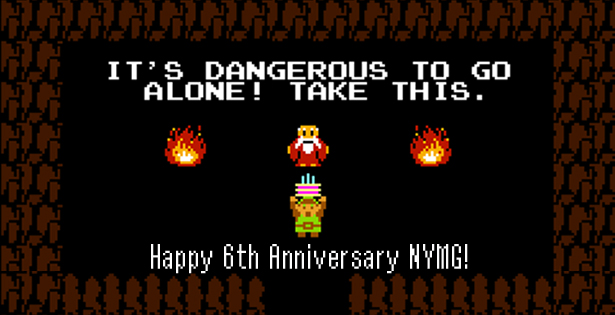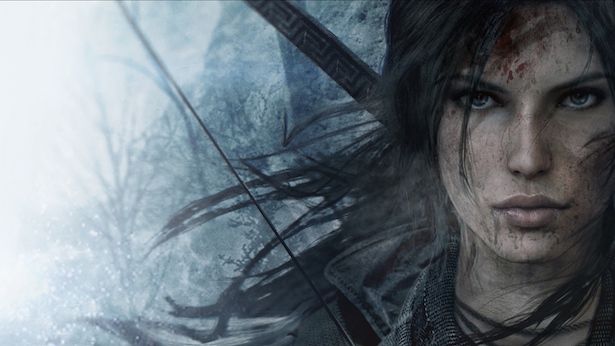When The Witcher 3: The Wild Hunt came out in 2015, critics and fans alike hailed the game as a video game standard-setter because of its stellar graphics, entertaining gameplay design, deft voice acting, and engrossing narrative. Jonathan Leack of Game Revolution called the game “one of the largest worlds ever created,” while Kimberley Wallace of Game Informer said it was a “genre juggernaut” and that she had “never felt so connected [to] a virtual world before.” Since The Witcher 3’s release two years ago, its studio, CD Projekt Red, has sold over 25 million copies.
The Witcher 3 also received attention when it came out because it features women in major narrative roles. Although the protagonist is a man, many of the secondary character are women, and a woman has taken charge of the universe’s destiny by the time the game ends. In an industry that’s dominated by male designers, highlights male characters, and caters to a male audience, the number of women given narrative significance in The Witcher 3 is remarkable. However, neither is the game a feminist triumph. The Witcher 3 frequently uses women as background decoration and downplays the power of its ambitious women characters.
The Witcher 3 is uneven in its treatment of women. It shows how carelessness, ignorance, and subtle, yet pervasive sexism can undermine the narrative potential of female characters in video games. Sometimes, The Witcher 3 sends the message that women aren’t in charge of themselves and their bodies, even if these women explicitly say they are. Sometimes, the game sends the message that women are just as capable and complex as their male counterparts. This messaging divide is both a shortcoming and a strength we – as members of the gaming community – can all learn from.
Let’s break down The Witcher 3: The Wild Hunt by going over its general treatment of women, then examining specific characters one by one.
Pixelated Breasts Here, There, and Everywhere
The Witcher 3: The Wild Hunt continues the story of Geralt, a monster hunter, or “witcher,” and Ciri, his super-powered foster daughter. CD Projekt Red’s games are inspired by Andrzej Sapkowski’s fantasy novels, which Sapkowski wrote in response to his disbelief that, in Polish folklore, a cobbler or baker could defeat powerful beasts. Instead, Sapkowski reasoned, a professional monster hunter would provide his services to peasants in the same way that a craftsman might. In The Witcher video games, goblins, sirens, giant spiders, and other violent creatures terrorize the hardscrabble villages of the Continent. Geralt, one of the last witchers, roves from town to town, taking contracts for a living. Once, he lived in the witcher of Kaer Morhen, raising Ciri as a witcher alongside his lover, the sorceress Yennefer. But Ciri disappeared years ago, and both Geralt and Yennefer are desperate to find her.
In The Witcher 3, the Wild Hunt, a band of terrifying alien elves, is also trying to find Ciri in order to carry out their own nefarious purposes. Ciri’s biological father, Emperor Emhyr of Nilfgaard, wants Ciri rescued from the Wild Hunt so that she can take her place as his heir. He employs Geralt and Yennefer – who parted ways long ago – to track down Ciri. This isn’t easy, since Ciri can travel through both time and space, so Geralt and Yennefer set off on a long, complex quest that takes both of them to the far reaches of the Continent.
Conventionally attractive women are used as set dressing from the very first village Geralt encounters. The Continent is full of blindingly attractive, often scantily-clad women who sometimes talk to Geralt about sex for no reason. In the city of Novigrad, ‘strumpets’ – unnamed female characters who wear next to nothing and proposition Geralt each time he passes by – rove the streets in packs. The game doesn’t explain why such a bafflingly high number of women have turned to prostitution, or how Novigrad’s economy sustains it. Nevertheless, Geralt may employ the services of women prostitutes at multiple brothels in Novigrad any time he wishes. The sheer number of breasts on display serves as eye candy for the majority male, presumed heterosexual player base. (According to Quantic Foundry, 74% of the people who play Western RPG-style games, like The Witcher 3, are men.)
The designers’ focus on women’s bodies does not extend to men. Male prostitutes seem not to exist – with a single exception. The Passiflora, a high-end brothel, features one male prostitute. (Why is there only one? Did the rest of the male prostitutes fight to the death for the title?) Geralt is not able to engage the man for sex, erasing the possibility of anything other than heterosexual encounters. Yes, according to Sapkowski’s books, Geralt is a straight man – but the designers changed the reference material enough to allow Triss Merigold to be Geralt’s potential “true love” in addition to Yennefer, whereas the books maintain that Yennefer is his soul mate. It doesn’t seem out of the question, then, that Geralt might be able to have sex with either a male or female prostitute. The game only allows for sexual and romantic encounters with women, however, leading to Kirk Hamilton of Kotaku to sardonically subtitle the game “The Witcher 3: Hello Ladies” instead of The Wild Hunt.
One of the game’s plotlines involves the despicable Whoreson Junior, who is a serial killer specializing in killing nameless strumpets. (Presumably he’s gotten away with it this long because there’s nothing to tell one apart from the next.) Geralt tracks Whoreson down in his manor and discovers the bodies of naked prostitutes literally functioning as window dressing. Whoreson Junior has nailed them to the wall, hanged them, and artfully arranged their corpses in the bathtub to look like sculptures. Some are spotlighted by lit candelabra, as if the women’s bodies are exhibits at a gallery. The point seems to be that Whoreson Junior is a very bad man who uses his social influence to order women up to his manor, then kills them and manipulates their bodies for fun. While the game condemns Whoreson’s behavior – Geralt can kill Whoreson the moment he finds him, or make him promise to change his ways – the body horror is excessive and pointless.
Hamilton of Kotaku agrees that designers seemed to intend for the
…[in The Witcher 3] women are singled out for sexual violation. A low point comes midway through the story when Geralt comes upon a scene of profound fucked-upedness, a group of women who have been sexually brutalized and murdered seemingly purely as a means of motivating players to kill the man responsible. (Probably would’ve wanted to kill him without seeing a dead prostitute nailed to the wall, thanks.)
The only comparable body horror scene featuring men comes much later, when the Ladies of the Wood, three old and evil beings who live in Velen, make a soup out of body parts. As they drink the blood of their male victims, tasting the men’s lives, the camera zooms in on a decapitated head. That’s it. The men’s naked bodies aren’t highlighted and posed, unlike in Whoreson’s house. Instead, the murder and carnage is implied through ominous shots of the cauldron. As a result, the scene isn’t gratuitous because it doesn’t toss around men’s mutilated bodies for effect.
In general, The Witcher 3 uses female bodies for shock and awe in a tone-deaf way, but doesn’t manipulate male bodies in the same method. Just because most of these details are in the background doesn’t make them irrelevant. In fact, it’s more telling of The Witcher 3 ethos that the designers toss in images of prostitute corpses just for a zesty storyline.
Triss, Yennefer, and the Disappearing Panties Trick
The Witcher 3 presents Geralt with two main romance options: Triss Merigold and Yennefer of Vengerberg. While Triss was Geralt’s lover in The Witcher 2, Yennefer is Geralt’s “true love” from the Andrzej Sapkowski books, as well as Geralt’s co-parent in raising Ciri.
Both Triss and Yennefer are accomplished magic wielders who are involved in the Lodge of Sorceresses, a secret political organization that counts the Continent’s most skilled sorceresses as its members. The Lodge has spurred a coup d’etat or two in the past, but they’ve also been unfairly blamed for the deaths of other leaders. When The Witcher 3 opens, Triss and Yennefer are both dealing with the repercussions of being marked women. They are also both attracted to Geralt.
Depending on players’ choices, Geralt may romance Yennefer, Triss, neither, or both. “Team Triss” or “Team Yen” are hills that Witcher fans are willing to die on en masse, and the “Great Waifu Wars” shows just how much players care which sorceress Geralt rides off into the sunset with.
It’s no surprise that fans are this attached, because the writers of CD Projekt Red have been able, for the most part, to construct Triss and Yen as fully-realized characters with their own motives, idiosyncrasies, and flaws. Yennefer is dramatic, severe, and proud, with a penchant for taxidermied animals and a fierce love for the people she lets into her inner circle. Triss is compassionate, resourceful, and an excellent healer, though ironically, she is allergic to potions. Yennefer and Geralt often engage in pun wars to see who’s more verbally adroit; Triss rakes Geralt over the coals every time he steps in to “save” her (she sees his actions as sometimes getting in the way of her autonomy). Only games willing to pay attention to character development would take the time to establish these character traits, which the game’s writers have done through both conversation and side quests. In addition, since Triss and Yen are good friends, the player walks right into the dynamics of a steadfast female friend ship if he chooses to romance either of them…or both.
It’s Triss and Yen’s character models and love scenes where the characters’ perfection falls apart. Though their words say that they are in charge of both themselves and the situations around them, their bodies are consistently on display, sometimes to an absurd degree. It’s worth noting that the depiction of Triss and Yen (both secondary characters) fits with Teresa Lynch’s findings in “Lynch’s 2016 analysis, released the year after The Witcher 3, shows that the overall rate of sexualized women in games has gone down since 1990s – for women protagonists, that is. Women who play secondary roles (which are more common than women in primary roles) are still sexualized. In Lynch’s study, sexualization means that characters’ breasts, bare midriffs, or other body parts are accentuated. Over-the-top, misplaced sexualization is also what ruins The Witcher 3’s narratives of Triss and Yen as powerful, respected characters.
The player meets Triss Merigold in Novigrad, where she’s on the run from King Radovid and his army of witch hunters. Though she’s supposed to be undercover, her skin-tight pants, bright red hair, and melon-sized breasts mean that she’s anything but hidden. Triss represents a young, vibrant sexiness in an environment where such sexiness makes no sense. When Geralt first encounters her, she takes him on a job hunting rats, which is the only way she can earn a few coins, she explains. Anti-magic sentiment is so bad that she’s only safe inside the witches’ hidden shantytown. But she’s saying all this as she and Geralt are running through the streets of Novigrad proper, and though the scene reads like a stealth mission – it’s night, Triss will be killed if she’s caught, and guards glower from the alleys – all the game does to hide her is provide her with a hood. Her famous red hair still peeks out from underneath, and her capelet provides a perfect glimpse of her breasts.
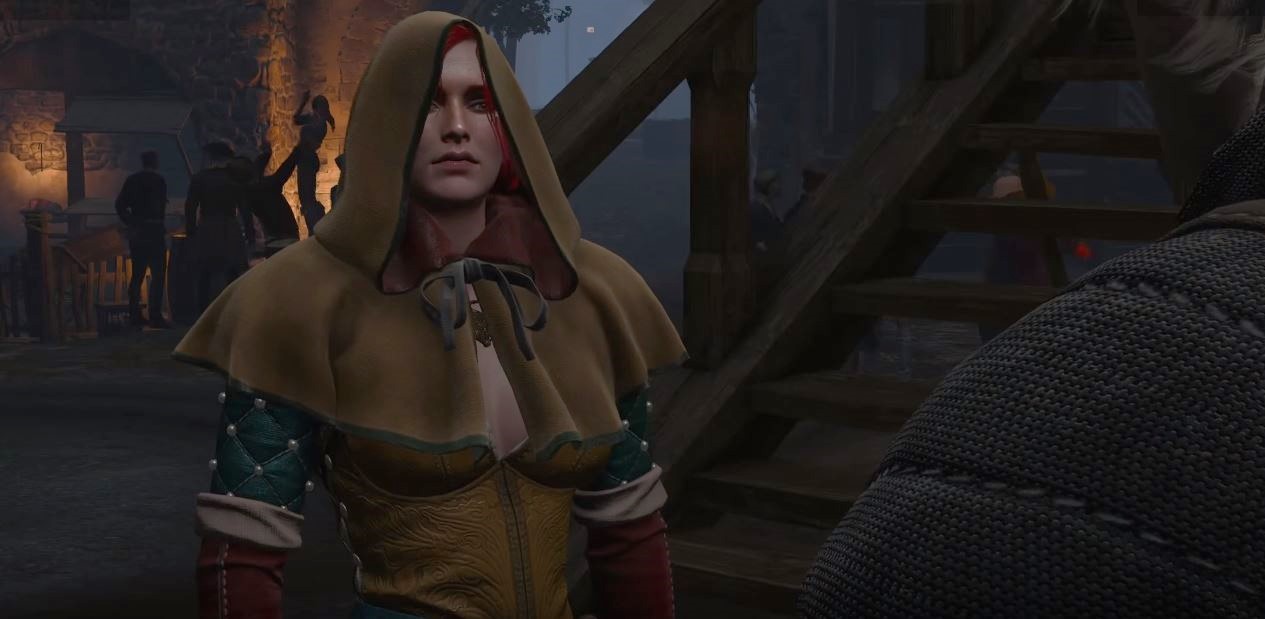
All this is unfortunate, because the unrealistic character model takes away from the concept of Triss as liberator and capable leader, which she grows into when she leads the mages of Novigrad to safety. Of course, it’s possible for a woman to be both sexy and capable, but the game seems to suggest that it is her physical appeal that matters most by constantly aiming the camera at her breasts when she’s talking.
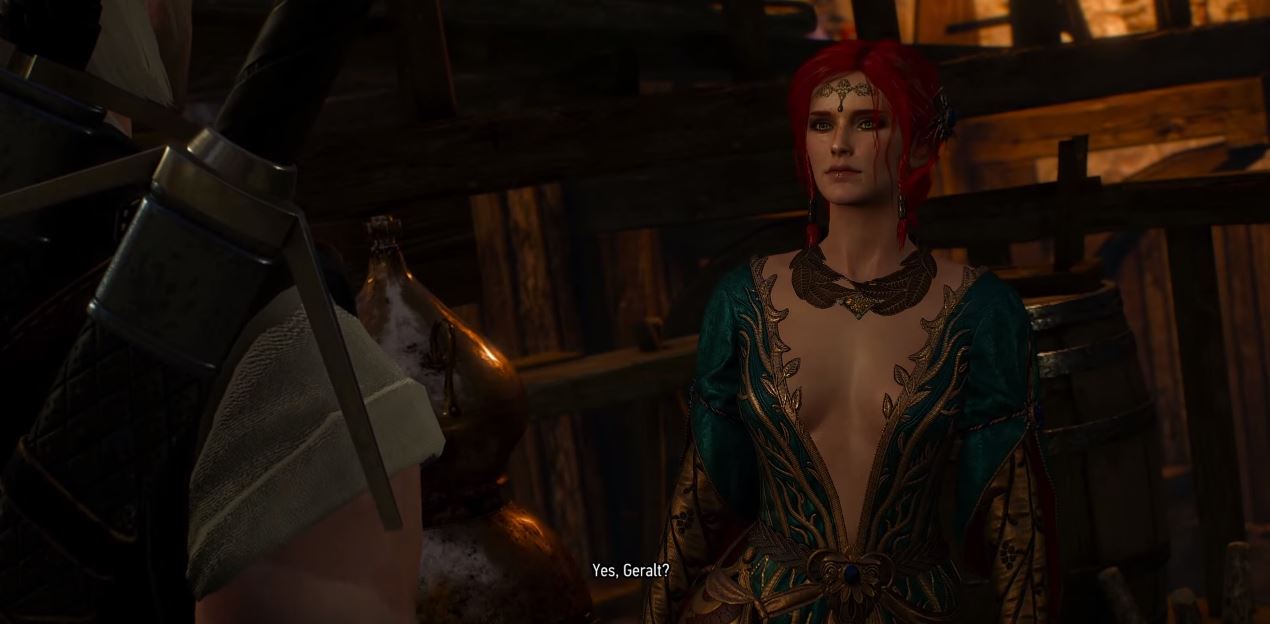
In this, her alternate outfit (which comes free with the base game, and which players can equip whenever they’d like), Triss’ cleavage and more is put on display. The outfit is absurd, especially in scenes like the one shown above above, where she’s trying to lay low in a boardinghouse run by non-sorceresses. By forcing Triss into revealing clothing when the situation calls for the opposite, The Witcher 3’s visual designers undermine her determination and fearlessness.
After his adventures in Novigrad with Triss, Geralt reunites with Yennefer of Vengerberg. Where Triss is impetuous, Yennefer is calculating. She’s been Geralt’s lover and companion for years before The Witcher 3, and the game positions Yennefer as Geralt’s equal by having Emperor Emhyr recruit both her and Geralt to find Ciri. To CD Projekt Red’s credit, Yennefer mostly does come off as his equal. She jockeys her way into Emperor Emhyr’s court sorceress so that she can get the resources she needs to find Ciri, her daughter in all but blood. The game repeatedly shows that Yennefer stops at nothing, including sacrilege and murder, to save those she loves. When she engages in necromancy by raising a young man from the dead, she even comes across as morally bankrupt – but, the game reminds players, she’s only doing this so that the man’s corpse will tell her where he last saw Ciri. No matter the player’s opinion of her actions, it’s hard to argue that she’s capable and efficient.
CD Projekt Red suffers from dual impulses when it comes to depicting Yennefer, however. Their design team has dressed Yennefer in a severe, imposing ensemble that incorporates a black fur ruff, belled sleeves, and a sturdy corset. These many layers de-emphasize her body – or so it would seem. Despite all Yennefer’s layers, the camera tracks her breasts and rear relentlessly. Her first scene, in which she stops Nilfgaardian soldiers from arresting Geralt, begins with a thigh and butt shot. Only then does the camera move to her face. When Geralt and Yennefer reunite in Skellige and Geralt briefs her on what he’s learned, the camera angle places her hips and rear at center stage for no discernable reason.
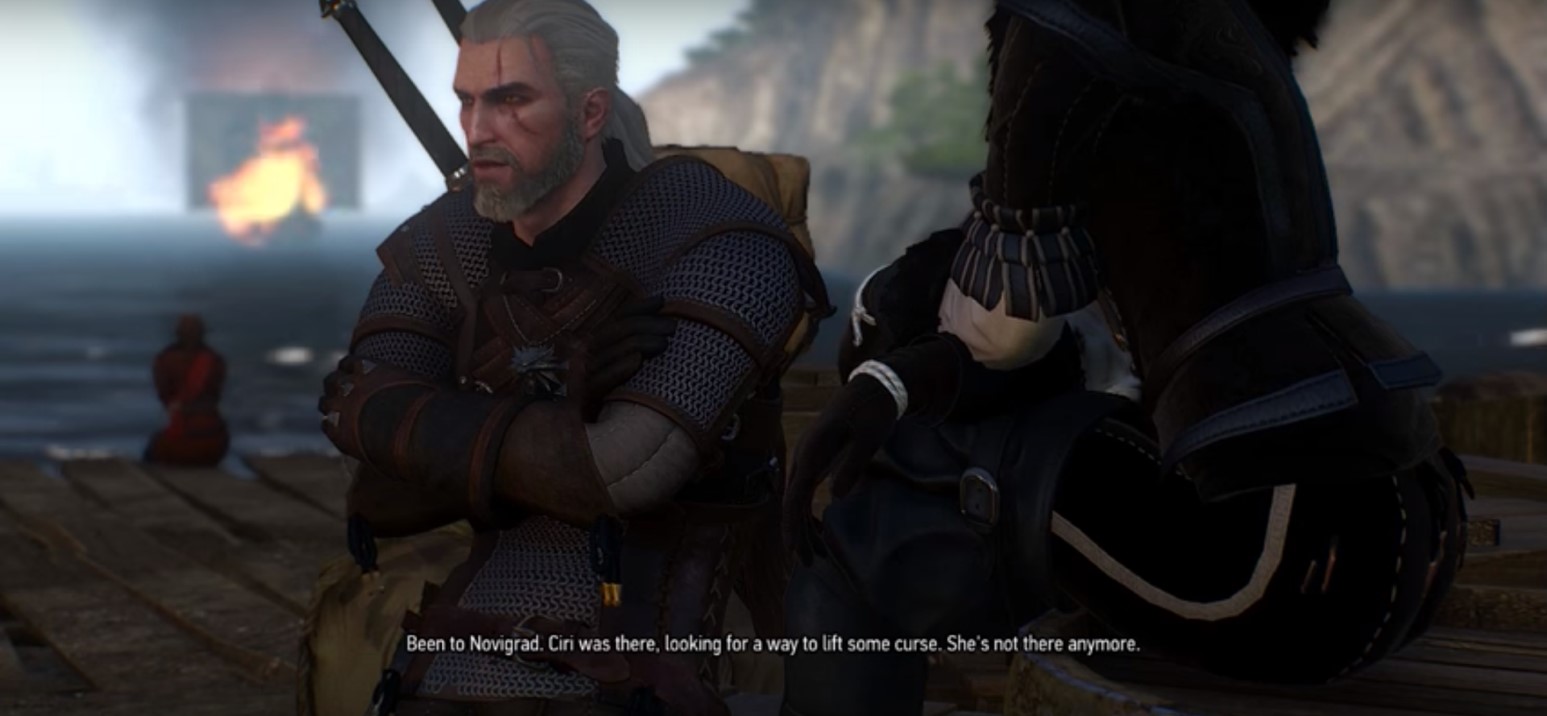
The Witcher 3 does this over and over with many female characters, but Yennefer is the most egregious example. Though Yennefer’s character model is not as objectifying as Triss’s, and fits her personality much better, the camera still railroads the player into staring at her ass…whether the player wants to or not.
The Witcher series has a reputation as an RPG with a side of softcore porn. In the first game, Geralt is Fantasy James Bond: he has the opportunity to have sex with hordes of women, and he receives an achievement card for each. The system is gross and objectifying and wrong, and people have already written about it at length. CD Projekt Red wisely ditched the sex cards for the second game, but they kept the constant nudity in both The Witcher 2 and The Witcher 3.
The Witcher 3 begins with naked people. Geralt bathes in a wooden tub while Yennefer sits nearby, wearing nothing but a towel around her wet hair. The camera focuses intently, almost pruriently, on Geralt’s spread legs and Yennefer’s breasts and rear, so the scene leads players to think that The Witcher 3 might feature equal-opportunity nudity. It doesn’t. Geralt can have sex with Yennefer and Triss. He can have sex with Keira (a possible romantic fling) and Madame Sasha and the Iron Maiden. He can hire prostitutes from Crippled Kate’s or the Passiflora. In every sex scene, the focus is on the woman’s body. Keira Metz’s substantial breasts heave during sex with such accuracy that it must have taken the designers great effort to perfect her boob physics. Both Yennefer and Keira make their underwear disappear with a wave of their hands and a flash of magical sparks, which is a neat trick but is also complete male wish fulfillment. Geralt not only makes their panties drop, he makes their panties vanish.
The player never sees any witcher dick, though, because Geralt (who is apparently a never-nude) wears white undershorts in every sex scene. Some players and designers have argued that this is fair, since men’s genitalia in the game would raise the rating beyond what many countries allow. That’s when fans and game designers alike have to ask themselves: why is full-frontal female nudity considered ‘mature,’ but full-frontal male nudity ‘X-rated?’
The Witcher 3 is also emotionally lopsided when it comes to Geralt’s romantic and sexual interests. If Geralt chooses either Yennefer or Triss as his lover, the game never deals with the emotional ramifications for the woman not chosen. There is no scene in which the two women resolve their issues and either repair or discard their friendship. Though Triss sees herself as Ciri’s older sister and Yennefer sees herself as Ciri’s mother, Ciri only gets several seconds’ worth of a reunion with them at Kaer Morhen. Yes, Geralt is the protagonist, but he frequently shadows conversations between other characters (like Dijkstra, Thaler, and Roche) in order to develop those characters’ relationships with each other.
The game does include one major exception to this trend: a quest called “Three to Tango,” in which Triss and Yennefer proposition Geralt for a threesome. If the player chooses to have Geralt tell both women he loves them, they will pull him aside and tell him they’d like to ‘share’ him. They bat their eyelashes, caress his chest, and nearly giggle as Triss requests that he come to an inn that very night.
When Geralt shows up, a bottle of wine in hand, the atmosphere is already sexually charged. Both women have stripped down to their underwear. “We couldn’t wait for you to show,” Triss says, implying that they’ve already begun having sex before Geralt enters. As they lead him to the bed and handcuff him to the bedposts, Geralt looks overcome with excitement (or as excited as a stone-faced witcher can seem, anyway). The scene reads like the beginning of a tastefully-costumed fantasy porno.
That is, until Triss and Yennefer pour themselves goblets of wine, toast each other with a wink, and walk out of the room to get drunk together. “Come back!” Geralt pleads. They don’t. He stays handcuffed to the bed all night, and only Dandelion’s eventual rescue gets him out.
In that moment, the player can practically hear the tape rewinding in Geralt’s head as he realizes that the sorceresses have used their sexuality as a tool. Since he’s tried to commit to both of them, Triss and Yennefer manipulate him with his greatest weakness: beautiful women. They slip on the stereotype of the sexually voracious, carefree “cool girl” that Gillian Flynn popularized in her novel Gone Girl:
Cool Girls are above all hot. Hot and understanding. Cool Girls never get angry; they only smile in a chagrined, loving manner and let their men do whatever they want. Go ahead, shit on me, I don’t mind, I’m the Cool Girl.
Men actually think this girl exists.
The Continent isn’t so different a place as the world of Gone Girl, it turns out. Geralt has acted as if his feelings are the ones that matter and then expects his lovers – two of the most powerful sorceresses alive – to just let him do it. It’s sexism at its most insidious. CD Projekt Red artfully turns that dynamic inside out by setting Triss and Yennefer up to be the ultimate Cool Girls. When the sorceresses humiliate the man who pigeonholes them as carefree nymphomaniacs, they become the powerful ones. As they saunter away from Geralt’s makeshift prison, they’re grinning. He’s not. It’s obvious who wins.
And yet. What do Yennefer and Triss do then? What do they talk about as they laugh, and drink wine, and laze around in their underwear? It’s the perfect opportunity for some character-building, and it would have been the cherry on top of the sundae that is the threesome fakeout sequence. The Witcher 3 does not include such a scene, though, and the camera returns, predictably, to Geralt.
It would have been easy for CD Projekt Red to work in more scenes for Yennefer and Triss that let the two grow as characters, but The Witcher 3 passes on this and logical opportunities to let these complex women take the lead. The game also passes on opportunities to dress and portray Yennefer and Triss with the same gravitas that the script gives them. In the end, the game seesaws back and forth, struggling to define them as individuals while also offering the occasional sharp insight into both characters.
Keira and Cerys
Keira Metz, one of Geralt’s possible romantic flings, is perhaps the best example of The Witcher 3’s uneven treatment of women characters. Geralt runs across Keira while searching for Ciri in Velen, a war-torn province full of swamps and fog. Along with Triss Merigold, Keira was once court sorceress to King Foltest, and she’s hiding from the political fallout of Foltest’s death in the bleak wilds of Velen.
From the beginning, the game presents Keira as a vixen whose body is constantly on display. When Geralt first meets her, Keira wears a low-cut dress unlike anything the peasants of Velen would put on. Just moments later, she’s disappeared into an illusion, which she invites Geralt into. “Don’t be shy,” she calls to him. Within the illusion, Keira is relaxing, naked, in a hot bath. The camera lingers on her exposed breasts, and so does Geralt’s gaze.
“Missed a spot,” he tells her. There’s no player choice here – he looks Keira’s nude body up and down regardless of the player’s feelings. The scene feels uncomfortably voyeuristic.
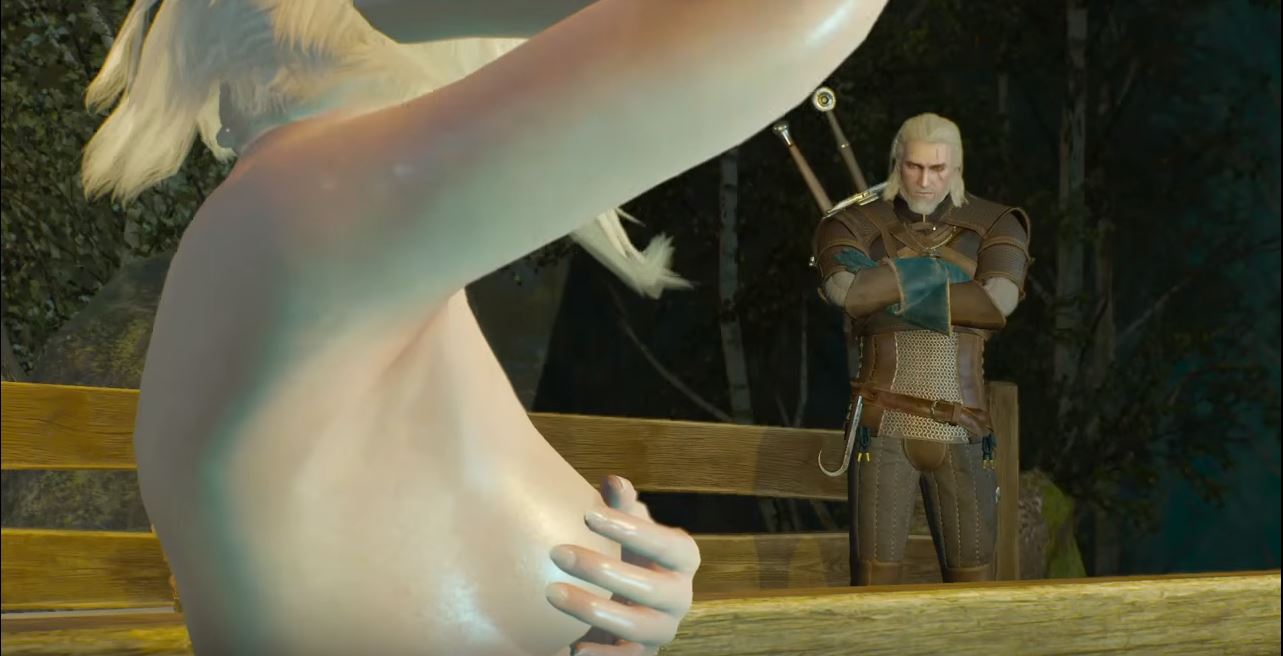
Geralt watches Keira bathe.
But that’s Keira’s goal – she planned this spectacle. A sardonic, intelligent, and ambitious woman, Keira has a flair for showmanship. And, in almost all her scenes, she makes her body into the star of the show. Later, she plans an elaborate dinner for herself and Geralt, complete with a moonlight ride on white mice transformed into horses. The whole time, she plies Geralt with wine and compliments. But sex with Keira is a ploy: she bewitches Geralt into a deep sleep, then steals priceless research from a nearby ruin while he’s out cold. This way, Keira achieves two goals: sex with Geralt, whom she openly desires; and a chance to uncover the research without Geralt stopping her. Just like Triss and Yennefer during “Three to Tango,” Keira weaponizes her sexuality to get what she wants.
When he finds Keira again, Geralt discovers that she plans to take the research to King Radovid in hopes of a royal pardon.
“This is suicide, Keira,” Geralt tells her.
“I don’t have a choice. I will have to parley,” Keira insists. The quest is called “For the Advancement of Learning,” but it isn’t just learning that Keira’s trying to advance. It’s her own right to exist.
If Geralt doesn’t try to persuade her, Radovid will indeed condemn Keira to death. In a gruesome scene, the game shows her body – the body she cared for with pride, the body she used to further her ambitions – impaled on a stake. Dried blood covers her mouth, and her dead eyes hold a look of horror. The Witcher 3 cleverly shows how Keira’s pride in both her mind and her body seals her own fate.
At least, the game almost does. It goes off the rails in an illustrated scene narrated by Geralt that plays before displaying Keira’s body. “Deep down, Keira was a little girl,” Geralt says. “She expected far too much of life and demanded instant satisfaction. Little girls end badly when they fall in with the wrong crowd.” The voiceover text characterizes Keira as no more capable or strategic than a child, and the preachiness seems off for Geralt’s typically non-judgmental character. The tone-deaf voiceover means that both the game and Geralt condemn and minimize Keira. The Witcher 3 thoughtlessly undoes a powerful woman in ten seconds after building up her character for ten hours.
However, Keira’s death isn’t guaranteed. If Geralt chooses empathetic conversation options, he can send Keira to the safety of Kaer Morhen instead. There, she will help Triss and Yennefer defend Ciri from the Wild Hunt, and she saves Lambert from dying. Keira survives both the witch hunt and the Wild Hunt, and she becomes more experienced and less selfish as a result.
Overall, though, The Witcher 3 can’t decide how much autonomy it wants to give Keira. In some scenes she seizes control, tricking both Geralt and the player so that she can get what she really wants. In other scenes, she’s portrayed as a confused, shortsighted little girl. Keira Metz is a microcosm of the game’s inability to achieve evenness in depicting a female character.
But not all characters are as unevenly treated as Keira. Where The Witcher 3 truly shines in telling a woman’s story is on the rocky, far-off isles of Skellige. The pirates and fishermen who have carved out lives for themselves on Skellige’s unforgiving shores give women more freedom than in other nations. Those who wish to fight can commit themselves to Freya, the mother goddess, and become shieldmaidens for their clans. They can also put themselves forward as claimants to Skellige’s throne, since the country has a nominal democracy: when a king dies, anyone (supposedly) can campaign to sit on the empty throne. In reality, though, only upper-class young men seem to become kings of Skellige.
That’s where Cerys an Craite comes in.
When Geralt arrives in Skellige, King Bran has just died. At his wake, the sons of the jarls (clan leaders) itch to declare their intentions. They all want to be king, but so does Cerys, daughter of Crach an Craite. Crach is the jarl of the an Craite family, and he’s groomed his son, Hjalmar, to be king. At Bran’s wake, Geralt and Yennefer are seated next to the jarls’ children. When Geralt says, “Seems they sat us with the sons of jarls. Exclusively,” Yennefer is quick to respond.
“Cerys an Craite is the daughter of a jarl, Geralt. Jarls’ daughters are in no way inferior to men.”
While well-intentioned, Yennefer’s words are almost immediately proven false (as Ruth points out in an excellent essay on FemHype). When Cerys points out that their fathers are the ones who will really choose the next king, the men at the table mock her for not participating in a footrace – years ago. And when she places her dagger on the table, signaling that she wants to be queen, nobody, including her father, takes her seriously. When Crach an Craite gives a speech about the qualities of a leader, he says, “A king must be wise. A king must command respect. A king must have bollocks.” Cerys, obviously, does not have bollocks. Yennefer and the Skelligers may say that Cerys is the equal of her male peers, but her peers’ words and actions during the banquet show that Cerys isn’t considered equal.
That doesn’t stop Cerys from both looking and acting like a contender for the throne. Her red hair is braided and pinned back, and she wears armor decorated with thick fur and the an Craite plaid. Cerys wears makeup, and the outlines of her woman’s body are vaguely apparent underneath her armor. However, since her body is so covered up, the camera never focuses on it. Instead, it consistently zeroes in on her scarred face. Unlike the game’s other women in secondary roles, Cerys doesn’t look like she could walk a Victoria’s Secret runway at the drop of a hat. Her femininity is present, but it isn’t an overwhelming character trait. It simply is.
When Cerys and Hjalmar journey across Skellige to commit feats worthy of a ruler, Hjalmar takes a large, all-male force to fight an ice giant. Every man except Hjalmar dies, and Geralt has to rescue the jarl’s son from peril. Even then, Hjalmar returns to the an Craite hall boasting of much-exaggerated achievements. He’s impetuous, conceited, and gets his clanmates killed.
Cerys, on the other hand, goes alone to cure a jarl of madness. She almost gets herself killed as well, but then realizes she’s out of her element and accepts Geralt’s help when he offers. She and Geralt are equals in brainstorming ways to lure the demon haunting the jarl. If Geralt chooses not to trust Cerys’ plan when they try to trick the hym, the jarl nearly dies during the exorcism. The game suggests that listening to Cerys is the most effective path. During her quest, she demonstrates the same impetuousness as her brother, but tempered by intelligence, curiosity, and a willingness to heed the words of others.
Later, the player can decide whether Cerys or Hjalmar should be ruler of Skellige. If Hjalmar becomes king, Skelligan ships continue to raid Nilfgaardian land, which fits with Skelligan culture but costs lives on both sides. If Cerys becomes queen, Skellige enters an age of peace and prosperity. Not only does Cerys seem like the better candidate, but her reign plays out better for her country. During her coronation, the jarls defer to her authority by swearing fealty to her. Everything in the scene – the swelling music, the iron circlet she places on her brow, her ringing speech – treats Cerys like the authority figure she deserves to be.
And yet she’s cautious. “What’s the new queen of Skellige planning?” Geralt asks her.
“Um…to listen, learn, and listen again. Then we’ll see,” Cerys says.
Impetuous yet ultimately wise and likable, Cerys is the game’s best example of a woman who takes charge of her own destiny in every way.
Princess Cirilla Gets Herself Out of the Damn Tower
Now let’s turn to Ciri, which is where the game’s gender dynamics get so complicated that you could think your brain into a pretzel as you try to decide whether Ciri is a well-developed female character or not. and you’ll see that people have argued the point back and forth for years.
Like most characters in the game, though, Ciri is neither a feminist idol (think Chell from Portal) nor a sexed-up damsel in distress (like Princess Peach) waiting to be rescued from a tower. The game designers do an admirable job of subverting the damsel trope, especially since the beginning of The Witcher 3 presents Ciri as the quintessential lovely princess fearing for her life. However, her ‘empowerment’ sometimes feels like an afterthought, and she suffers from the same unrealistic character model traits that plagues the rest of the women in the game’s cast. (Megan Patterson, writing for The Mary Sue, refers to these uniformly perfect models as having “hot boob disease.”)
Princess Cirilla, Geralt and Yennefer’s foster daughter, is the focus of The Witcher 3 – but she’s not a main character until close to the end. The game begins with a sunny, idyllic scene in which Geralt and the rest of the witchers train a freckle-faced little girl: Ciri. Even as a child, she can wield a sword, outrun her father, and recite monster facts with Hermione Granger-like detail. The message is clear: this kid is not to be trifled with.
Then the scene dissolves in a dark flash, and the player realizes that Geralt was dreaming. It’s fifteen years later, the Wild Hunt is after Ciri, and a cadre of main characters is looking for her. For the first two acts, Ciri is the object of a long and arduous quest. But that doesn’t mean she’s not also part of it. As Geralt uncovers clues that point to Ciri’s location, The Witcher 3 doles out flashbacks that feature Ciri, not Geralt, as the player character. In all three Witcher games, Ciri is the only character other than Geralt that the player can control. By making Ciri a player character, the game designers suggest that she’s worthy of being a heroine.
The flashback sequences with Ciri are a narrative device meant to let the player get as close to Ciri’s trail as possible. When Geralt finds a character who saw Ciri, the game doesn’t just summarize that person’s account: it jumps back to the moment in question. During these parts, Ciri is unquestionably the hero. She saves a little girl from dying at the hands of werewolves in Velen, and she takes down more bandits than Geralt ever could while escaping Novigrad. The game’s mechanics, however, don’t lend Ciri the kind of depth Geralt has.
When controlling Geralt, players use a complicated system of equipment, sword oils, potions, and spells to deal specialized damage. Defeating enemies means constantly changing tactics, because what kills a water hag won’t scratch a golem. That’s what makes combat fun. Ciri’s combat, though, is nothing like that. She can do exactly two things: swing her sword and teleport around the screen in quick flashes. This makes her into superweapon who can take down most enemies immediately. It also makes her boring.
Building out a separate combat system for Ciri would have been a poor design choice, since getting thrown into an unfamiliar character’s body and using new, yet complex mechanics would give many players whiplash. Giantbomb calls such swapping of assets disorienting, and disorientation clearly wasn’t what the designers had in mind: Ciri’s episodes are supposed to slot effortlessly into Geralt’s story. So why not keep Geralt and Ciri’s mechanics more or less the same? Why did it feel like playing as Ciri was an afterthought?
In addition, Ciri suffers from Chainmail Bikini syndrome. That is, her character is written as physically powerful and a capable warrior, but her character design is impractical for any combat situation. Her original outfit takes great care to show her bra and breasts at all times, and her alternate outfit leaves her stomach bare. She wears heels while fighting, and her eye makeup is always thick and perfectly applied, even when she’s ‘dead’ on the Isle of Mists or fighting the generals of the Wild Hunt. Arthur Gies of Polygon lists scenes where he sees women “comically sexualized,” and he refers to one in which Ciri changes to a fur-lined outfit for cold climates but keeps her unbuttoned shirt as “truly worthy of eye-rolling.”
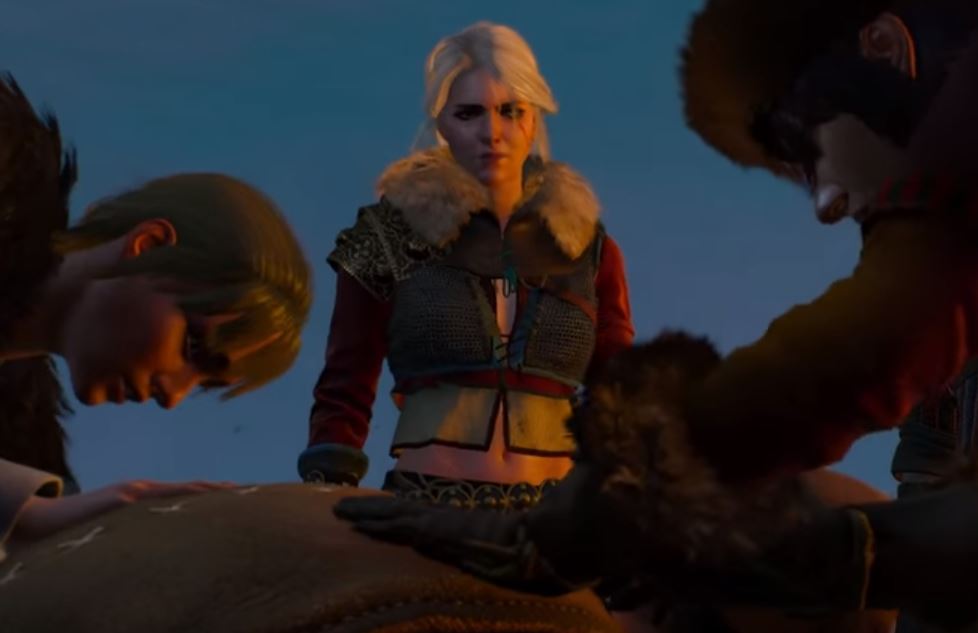
Ciri’s cold-weather gear, complete with a keyhole neckline and bared midriff. Image
Despite all these flaws, the game’s endings depend on whether or not Geralt treats Ciri as an individual, capable of deciding her own future, or merely as an extension of himself. Once Geralt recovers Ciri from the Isle of Mists, the player has a series of choices to make regarding Ciri’s actions. Two powerful and influential sorceresses ask to speak to Ciri alone, and Geralt can accompany Ciri or let her handle herself. Ciri wants to find and kill Caranthir, one of the generals of the Wild Hunt, and Geralt can go with her to help carry out that task or prevent her from going at all. Later, Geralt can help Ciri bury the body of a man who helped her while she was on the run, or he can tell her that there’s no time.
A protective, worried father figure – especially one who’s just recovered his daughter from what he thought was certain death – might not allow Ciri to do any of these things. However, if the player chooses to keep Ciri safe at every turn, she will doubt her own abilities while fighting the Wild Hunt and die to keep the White Frost at bay. A series of quick flashbacks shows Geralt shielding Ciri and stopping her from taking action. On the other hand, if the player has Geralt encourage Ciri to take charge of her life, the flashbacks show Ciri making decisions for herself and Geralt supporting her as she makes them. She survives the fight and either becomes Empress of Nilfgaard or a witcher. Ciri is the first woman to do either. Damsel in distress? Sorry, wrong number.
The game’s ‘positive’ outcomes, in which Ciri lives, tell a powerful and emotional story of a daughter’s growth and eventual independence. Though Geralt saves Ciri from the Wild Hunt, she saves him (and everyone else) from the White Frost, which is slowly encroaching on their world as the Wild Hunt flees the entropic force that turns every place it touches to ice. Geralt and Ciri make each other into more principled, capable people. It’s an ideal, surprisingly modern parent/child relationship writ across the backdrop of epic fantasy. Though Ciri’s sexualized character design and simplistic gameplay mechanics don’t mesh with the emotional way she’s written, she still makes the entire game worth playing.
Conclusion: Looking Smashing for the Occasion
“Women only beautify themselves for their own satisfaction,” Keira Metz tells Geralt before the Wild Hunt descends on Kaer Morhen. She’s peering at her own reflection as she says this, and brushing her hair with care. “If I’m to die today, I wish to look smashing for the occasion.”
The Witcher 3: The Wild Hunt wants to convince players that it, too, can get behind modern and feminist ideas, like women beautifying themselves for their own satisfaction rather than that of men. It wants to present women who are powerful enough to kill, and heal, and bear swords, and cast spells. It wants to give them space to come alive in a genre that’s traditionally dominated by gruff, masculine “weapons of mass decapitation.” Sometimes The Witcher 3 triumphs, as with Ciri and Cerys. Sometimes it teeters on the brink of cutting social commentary, as with Keira, Triss, and Yennefer. In many scenes, though, the game carelessly turns women into the very vixens it’s tried so hard to avoid.
The Witcher 3 is anything but consistent in portraying female characters, which is why it serves as an important lesson to game designers: sexism, like any form of prejudice, creeps in like mold. Despite designers’ worthy efforts to depict the game’s women as fleshed-out characters, The Witcher 3 could have done a much better job. It especially could have improved its 3D character models and cutscene camera angles, and it could have included more scenes that let women’s relationships come to the fore.
The Witcher 4 designers? Are you listening? You have a daunting task ahead of you. But The Witcher 3 has already pointed out what’s possible – and what must be improved.
Elizabeth Ballou writes fiction, journalism, personal essays, and the odd video game. She is the creative director of Green Willow Games, an indie game studio, which released the mystery/adventure game Gray Skies, Dark Waters.

